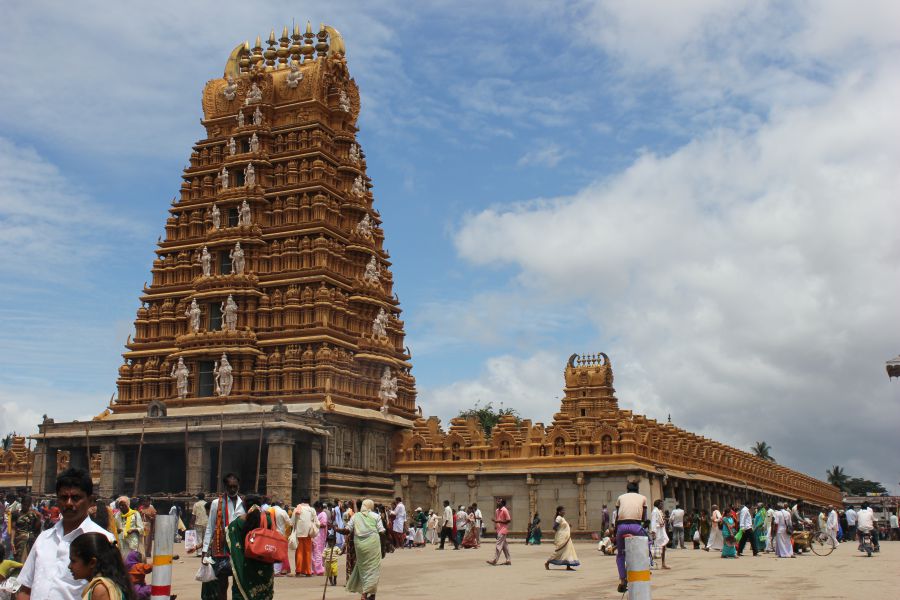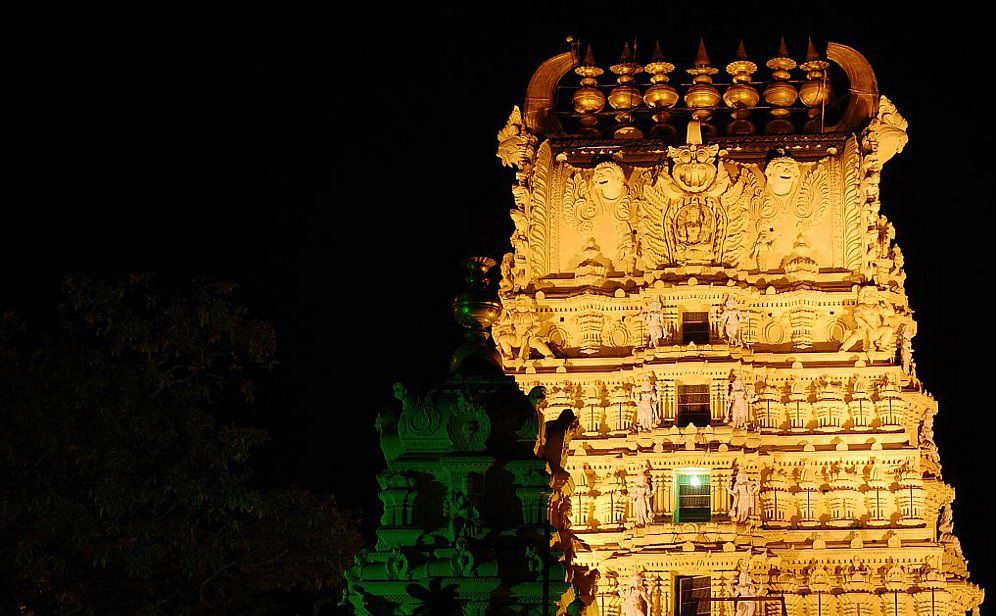No products in the cart.
Representatively, the Temple Gopuram or the access to the temple represents the feet of the divinity. A devotee bows at the feet of the Lord at the entry as he steps into the temple and proceed towards the chamber, leaving behind the world of contradiction.
A Gopura is usually constructed with an enormous stone base and a superstructure of brick and support. It is rectangular in sketch and topped by a barrel-vault roof crowned with a row of finials.
When viewed from apex, the Gopura too resembles a mandala; with sculptures and carvings of Yalis and mythological animals to be found in the outer enclosed space. Humans and divine beings are in the central enclosures. The crest of the Gopura, the Kalasha, is at the centre of the Mandala.
 These sculptures follow a selection of themes resulting from the Hindu mythology, mainly those associated with the presiding idol of the temple where the gopuram is positioned.
These sculptures follow a selection of themes resulting from the Hindu mythology, mainly those associated with the presiding idol of the temple where the gopuram is positioned.
Gopuram is not anything but a pyramidal structure. Our ancestors knew that the pyramidal structures are the most paired structure in the world that is why the pyramid at Egypt is still stationary.
The pyramidal structures give optimistic energy and vibration to the devotees. The gopuram was constructed to great heights, this is for the reason that the old populace who cannot come to temple can also pray their deity by sitting at their place just bearing in mind the gopuram.
Cultural Importance of Temple Gopuram
In early days, Temples served as the major landmarks of the land. A place was recognized either using the palaces or temples. As the palaces were prone for being ruined due to assault, temples served as the chief landmark for the passengers.
In order to make easy the roaming folk to recognize the locations easily, the Gopuram’s of the temples had to be built elevated. That tiled way for the elevated Gopuram’s.
By way of seeing the Gopuram’s form expanse, passengers planned the approximate distance of their target from their location. Gopuram’s were built extremely high to serve as landmarks as well as for traveler distance’s.
Additionally, temples served as the main protection for travelers. When people travel between places, they stay at the temple building to take rest. Before they commence the new part of their journey, they would respect God and begin.
Gopuras come into view to have inclined revision in the temple plan and outline. The spaces just about the shrine became hierarchical; the further the space was from the central shrine, the lesser was its distinction. The farthest ring had buildings of a more practical or a secular nature – shops, dormitories, sheds, workshops etc., thus transforming the temple from a merely place of worship to the center of a vibrant alive city.
A particularly appealing example of this is the Sri Ranganatha temple at Sri Rangam, which has seven enclosed space walls and as many as twenty-one Gopuras, the seventh, the external most area encloses an area of about six hundred acres.
In the Sri Rangam temple the seven concentric prakara walls are said to symbolize the seven layers of matter-earth, water, fire, air, either, mind and intelligence-that enclose the awareness of the living entities in the material world. The Gopuras are representative of being unbiased from the oppression of matter as one enters the temple and proceed toward the innermost shrine.
Scientific Reason for the Temple Gopuram

Gopuram acts as a lightning seize. A metallic item mounted on top of a structure, electrically bonded using a wire or electrical conductor to interface with land or “earth” through an electrode, engineered to guard the building in the event of lightning hit. If lightning targets the structure it will preferentially strike the rod and be conducted to ground throughout the wire, instead of passing all the way through the building, where it could create fire or cause electrocution.
The science behind these constructions is that, the temple architecture gives cosmic force to the main idol in the Garbha Griha. Firstly, the Juathaskambam acts like an antenna and receives the cosmic force from the space and through a subversive channel it is linked to the main idol in the Garbha-graha. The cosmic force continuously flows through the Jathuskambam to the statue and energies it. Secondly, the celestial power fetched through the field gives the idol effulgence and metaphysical powers. The cosmic-force is additionally maintained by noise waves (Vedic chants – Read about the Significance of Chanting) and the pyramid like tomb. The pyramid like construction helps to intensify and protect the cosmic force. These are the reasons for anybody to feel a positive energy, goodness, serenity or divinity when we approach the interior sanctum.
The copper plate has the propensity to suck part the Ether when that penetrates from the copper and the Herbal resulting in powerful atomic force that penetrates through the skin to heal the human, and that’s why the copper plate is put on the temple tower.
Interesting Facts About Temple Gopuram
The idol is washed with various materials (milk, sandal paste, oil) to preserve the idols. The idol is adorned with flowers and ornaments for mental and visual boost. But the diverse postures of the idol (sitting/standing, number of hands, weapons they hold) do have meaning in emitting the cosmic force.
Thus the temples serve up as the scientific room to receive the shower of cosmic force or God’s blessing.








From my understanding Temple Gopurams are an important part of any Hindu temples and there are specific reasons for their existence. They are:
1) Temple Gopurams are built to receive the positive energy from the universe. Cosmic rays will be received by the Gopuram and it will be passed to the statue in the temple.
2) Gopuram will also receive the energy from thunder/lightning and pass it to the ground. So it acted as a layer of protection for the temple and the nearby areas.
3) Temple Gopuram were built largely to depict the culture and art of ancient people
4) It also used to act as a landmark in olden days to find out the cities, way to different places.
5) In olden days , kings built temples in order to give job to the people of the country and along with that future generations will come to know the architectural talents that ancient people had.
6) The small carvings and statues in temple gopuram depict the story of the god and also will show life lessons.